Local residents who want to donate furniture will have an easier time connecting to people in need thanks to the work of a team of first-year students from the Milstein Program in Technology & Humanity.
Another team of Milstein students is creating a curriculum that will be used by a third team to teach students here and in Haiti the computer language of SCRATCH, while a fourth team traveled to Guilford College in North Carolina over spring break to design a virtual reality tour for an Underground Railroad site there.
A student working on the Underground Railroad Project in Guilford College points to a nail placed in the side of a tree to show people escaping slavery the correct direction to travel.Service is an essential piece of the Milstein Program, since it connects students to real-world implications of technology, allows them to discover the importance of giving back as a life pursuit, and encourages them to collaborate with community partners in genuine exchange,” said Amy Villarejo, professor of performing and media arts and faculty director of the Milstein Program.
While students are working on their projects, they’re also welcoming a new group of Milstein students who were just accepted into the program this semester and met other students and faculty at a dinner on May 7. Their interests range from Near Eastern studies to math and physics to biological sciences; like the current Milstein students, they are excited to be part of the first cohort.
The Milstein Program, in its first year, is for students who have interests in both technology and the humanities. It combines the benefits of a liberal arts education in the College of Arts & Sciences with two summers spent taking courses and completing projects at Cornell Tech in New York City. The program aims to have 25 students per class with two points of entry; the first upon admission, and the second at the end of the freshman year, for a total of 100 Milstein students on campus.
The spring semester service projects are part of the Milstein “Collab” class, which all first-year students take. The Collab combines academic modules (on journalism, citizen science, data collection, privacy issues and so on) with co-curricular exploration that helps build cohesion among the participants. During the collaboration class, students take part in a variety of activities including Cornell’s Intergroup Dialogue Project, a critical reflection workshop and sessions focused on teamwork. They also choose from a number of service projects.
Catie Rencricca ’22, is working on the Love Knows No Bounds team, which is helping create a website for the furniture redistribution organization. “They need a way, as the organization grows, to streamline their processes, and manage their data more efficiently,” she said. The website will allow people to enter information about the items they need or items they want to donate, as well as information about pickup.Students on the team — Rencricca, Andrew Gao ’22 and Ray Weng ’22 — drew a schematic of the types of information they would need to corral as they made plans for the most efficient way to create the database and the website. They also considered factors related to privacy, cost and ease of use.
Tiffany Zhong ’22, part of the Underground Railroad team, said the focus of her team’s work changed after their trip south.
“Before I went, I had this expectation that our work would be all about combining CS (computer science) and film,” she said. “But I learned so much about the history of the Underground Railroad, I realized it was more about balancing the viewpoints of the story and weaving together storytelling, history and technology.”
Their project is to help students and faculty at Guilford College create an interactive audio/video tour for a southern terminus of the railroad, centered around the New Garden community in Guilford County, N.C.
The students involved in the Haiti project are creating tutorial videos to help young students learn SCRATCH, a computer language that helps teach basic coding skills. One challenge they face is that many kids they’ll be reaching have never seen a computer before.
“I started using SCRATCH in sixth grade,” said Reza Madhavan ’22. “I think that’s where my interest in computers came from. I don’t know if I would be in CS without SCRATCH.”
The videos will start with simple information about the main functions of a computer and connecting to Wifi, Madhavan said. “By the end of the sixth video, they should be able to play around and create something.”
Students in the second half of the Haiti group will be collecting and refurbishing computers and other tech equipment and sending them over to Haiti. They are also working with the Sonje Ayiti Organization/Remember Haiti, their community partner there, to translate the SCRATCH tutorials into Haitian Creole.
“I chose to work on this project because it encompasses so many of my own interests, especially that of cultural exchange,” said Bliss Zheng ‘22. “The group in Haiti didn’t want this to just be a simple ‘collection and donation’ project that would be over once the computers were in Haiti. Instead, they emphasized fostering a long term relationship with us and the students and stressed how both groups can learn a lot from each other.”
Many of the Milstein students said they will continue working on their projects when they return in the fall — and perhaps recruit some of the new Milstein students to join them.
The SCRATCH project team already has plans to use their curriculum with students at Tompkins-Seneca-Tioga BOCES.
“We’re creating lessons plans to do our tutorials in person at BOCES because a lot of kids in the surrounding areas don’t have the opportunity to learn SCRATCH either,” Madhavan said.





